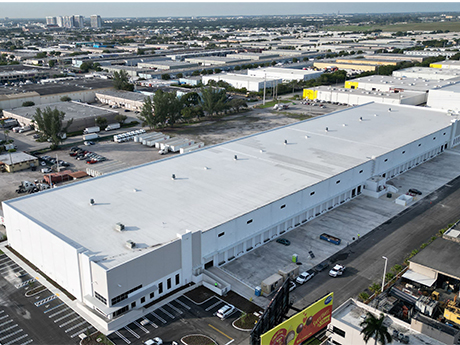By Ben Eisenberg of Transwestern
In 2023 and continuing into 2024, Miami’s industrial sector experienced moderate growth due to reduced lease turnover and despite accelerating interest rates and economic uncertainty. However, the market’s strong industrial fundamentals and international connectivity via Miami International Airport and PortMiami continue to demonstrate its enduring strength and resilience.

Miami’s industrial market is powered by freight, logistics and e-commerce demand, along with traditional distribution, service and light assembly. The region continues to experience steady population growth that drives sustainable consumption of goods and services and, ultimately, the need for warehouse space.
Accounting for nearly 27 percent of Florida’s overall population, Miami was home to more than 6.2 million people at the end of 2023 and is projected to grow to 6.3 million this year. The region’s population has expanded by nearly 7.6 percent over the past 10 years. Increased migration to the Sun Belt has boosted wealth, disposable income and consumption, making Miami one of the nation’s wealthiest metro areas, with some of the highest average home values.
In the first quarter of 2024, Miami’s unemployment rate reached a record low of 1.5 percent and has remained below 2 percent since the fourth-quarter 2022. The region’s industrial labor participation has steadily increased since March 2021. Even at a decelerated growth rate of 2.2 percent in February 2024, it still outperformed the national average by 180 basis points.
The development barriers of the Atlantic Ocean to the east and the Everglades to the west have intensified vertical development in the Miami region, which affects employment, consumption and industrial development costs.
While construction deliveries slowed slightly in the first quarter, approximately 605,850 square feet of new industrial space was delivered, primarily in the Miami Airport submarket. Notable developments include Royal Palm Doral, a two-building, last-mile warehouse property by Link Logistics that added 345,000 square feet of new Class A leasable space to the local supply.
Debt market challenges notwithstanding, developers continue demonstrating confidence in Miami’s ongoing demand for premium space. Current construction activity spans 4.9 million square feet across seven of 11 submarkets, led by Medley, North Dade/Gratigny and Miami Airport, which alone has 1.9 million square feet in progress. Link Logistics is preleasing Sycamore Logistics Center, a 310,456-square-foot, two-building project in Medley that will deliver later this year.
Miami’s net absorption dipped to 455,201 square feet last quarter, which is still significant for a market that has averaged 2.4 million square feet of annual net absorption for the past 13 years. As Miami’s largest submarket, Miami Airport saw a positive absorption of approximately 550,000 square feet, reversing three consecutive quarters of negative absorption.
Meanwhile, North Dade/Gratigny, which ranks second for inventory, new construction and absorption, has made a strong recovery from the fourth quarter of 2023, with 141,000 square feet of net absorption this quarter.
An uptick in vacancy was expected due to new construction, moderate absorption and economic anxiety. Although Miami’s vacancy rate slightly increased to 3.2 percent during the first quarter of the year, it remains historically low and 250 basis points below the national average.
For perspective, Miami’s industrial vacancy rate is lower than any quarter on record before the third quarter of 2021 and is 120 basis points below the three-year average leading up to the pandemic. As the impact of new supply wanes, Miami’s vacancy rate is expected to tighten again.
With double-digit rent growth year-over-year in the previous 11 quarters, rental rates predictably decelerated in the first quarter of 2024, with a 5 percent increase year-over-year, compared to 26 percent recorded three quarters earlier. The Medley submarket had the highest year-over-year asking rent growth at 29 percent, while Hialeah, historically at the bottom for asking rental rates, recorded 28 percent year-over-year growth.
In the capital markets, Miami came off $1.5 billion in investment sales in 2023 to record $271 million in transactions in the first quarter, surpassing the same period last year. Although sales activity is lower than the three-year quarterly average of $503 million, the average sales price remains relatively stable at $235 per square foot. In the face of elevated interest rates, high-priced deals are still prevalent across various submarkets, with smaller buildings selling well above the market average.
Private investors nearly doubled their sales footprint from 2022 to 2023, accounting for 90 percent of all first-quarter 2024 sales transactions in Miami. Institutional buyers, involved in almost half of all deals in 2022, comprised only 5 percent of transactions.
While challenges persist in the lending environment, Miami’s strong market fundamentals, including strong migration, employment and labor participation, continue to attract capital deployment. While overall absorption and rent growth are expected to remain subdued through 2024, diverse demand drivers, limited developable land and Miami’s strategic position as a primary logistics hub instill confidence in ongoing investment interest in the region’s industrial market.
— By Ben Eisenberg, executive managing director of Transwestern. This article originally appeared in the May 2024 issue of Southeast Real Estate Business.


